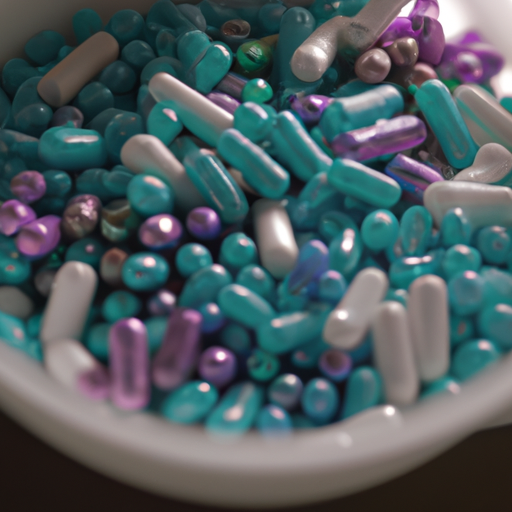-
Table of Contents
Adderall is a prescription medication used to treat attention deficit hyperactivity disorder (ADHD) and narcolepsy. It is a combination of two stimulant drugs, amphetamine and dextroamphetamine, which work by increasing the levels of certain chemicals in the brain. Adderall comes in several forms, including tablets, capsules, and extended-release capsules. It is important to know what Adderall looks like so that you can identify it and make sure you are taking the correct medication. In this article, we will discuss the different forms of Adderall and what they look like.
How to Identify Adderall: What Does It Look Like?
Adderall is a prescription medication used to treat attention deficit hyperactivity disorder (ADHD) and narcolepsy. It is a combination of two stimulant drugs, amphetamine and dextroamphetamine, and is available in both immediate-release and extended-release forms.
Adderall is typically sold in tablet form and comes in a variety of colors and sizes. The immediate-release tablets are usually white, orange, or pink and are available in 5, 7.5, 10, 12.5, 15, 20, and 30 milligram (mg) doses. The extended-release tablets are usually blue, yellow, or gray and are available in 5, 10, 15, 20, 25, and 30 mg doses.
Adderall tablets are usually round and have a score line down the middle, allowing them to be split in half. The tablets may also have the letters “AD” imprinted on one side and the dosage amount on the other side.
It is important to note that Adderall is a controlled substance and should only be taken as prescribed by a doctor. Taking Adderall without a prescription or in higher doses than prescribed can be dangerous and can lead to serious health problems.
The Different Forms of Adderall: What Do They Look Like?
Adderall is a prescription medication used to treat attention deficit hyperactivity disorder (ADHD) and narcolepsy. It is a combination of two stimulant drugs, amphetamine and dextroamphetamine, which work by increasing the levels of certain chemicals in the brain that are responsible for controlling attention and behavior. Adderall is available in several different forms, each with its own unique characteristics.
The most common form of Adderall is an immediate-release tablet. These tablets are taken orally and are available in 5mg, 7.5mg, 10mg, 12.5mg, 15mg, 20mg, and 30mg doses. The tablets are typically white or blue in color and are round or oval in shape.
Adderall XR is an extended-release capsule that is taken orally once daily. It is available in 5mg, 10mg, 15mg, 20mg, 25mg, and 30mg doses. The capsules are typically orange or pink in color and are oval in shape.
Adderall IR is an orally disintegrating tablet that is taken orally and is available in 5mg, 7.5mg, 10mg, 12.5mg, 15mg, 20mg, and 30mg doses. The tablets are typically white or blue in color and are round or oval in shape.
Adderall SODA is a solution for oral administration that is available in 5mg/5mL, 7.5mg/5mL, 10mg/5mL, 12.5mg/5mL, 15mg/5mL, 20mg/5mL, and 30mg/5mL doses. The solution is typically clear or light yellow in color and is packaged in a bottle with a dropper.
Adderall ODT is an orally disintegrating tablet that is taken orally and is available in 5mg, 7.5mg, 10mg, 12.5mg, 15mg, 20mg, and 30mg doses. The tablets are typically white or blue in color and are round or oval in shape.
Adderall is also available in a generic form. The generic form of Adderall is available in the same forms and doses as the brand-name version.
No matter which form of Adderall you choose, it is important to take it exactly as prescribed by your doctor. Taking too much or too little of the medication can lead to serious side effects. If you have any questions about the different forms of Adderall, be sure to talk to your doctor or pharmacist.
The Dangers of Taking Adderall: What Does It Look Like?
Adderall is a prescription medication used to treat attention deficit hyperactivity disorder (ADHD) and narcolepsy. It is a stimulant drug that increases alertness, attention, and energy. While Adderall can be beneficial for those with ADHD and narcolepsy, it can also be dangerous if taken without a prescription or in excessive amounts.
The most common side effects of Adderall include insomnia, loss of appetite, dry mouth, headaches, and stomach pain. In addition, Adderall can cause more serious side effects such as increased heart rate, high blood pressure, and even heart attack. It can also lead to addiction and dependence, as well as an increased risk of mental health issues such as depression and anxiety.
Adderall can also have dangerous interactions with other drugs, including alcohol. Combining Adderall with alcohol can lead to serious health risks, including liver damage, increased heart rate, and even death.
Taking Adderall without a prescription or in excessive amounts can also lead to serious legal consequences. Possession of Adderall without a prescription is a felony in many states, and can result in jail time and hefty fines.
In conclusion, Adderall can be a beneficial medication for those with ADHD and narcolepsy, but it can also be dangerous if taken without a prescription or in excessive amounts. It can lead to serious side effects, addiction, and legal consequences. Therefore, it is important to only take Adderall as prescribed by a doctor and to be aware of the potential risks associated with taking it.
The Side Effects of Adderall: What Does It Look Like?
Adderall is a prescription medication used to treat attention deficit hyperactivity disorder (ADHD) and narcolepsy. It is a combination of two stimulant drugs, amphetamine and dextroamphetamine, which work by increasing the levels of certain chemicals in the brain that are responsible for controlling attention and behavior.
However, Adderall can have a range of side effects, some of which can be serious. Common side effects include:
• Loss of appetite
• Nausea
• Headache
• Dizziness
• Insomnia
• Dry mouth
• Weight loss
• Stomach pain
• Diarrhea
• Constipation
• Increased heart rate
• High blood pressure
• Anxiety
• Agitation
• Restlessness
• Irritability
• Mood swings
• Depression
• Hallucinations
• Aggression
In addition, Adderall can cause more serious side effects, such as an increased risk of heart attack, stroke, and sudden death. It can also lead to addiction and dependence.
If you experience any of these side effects while taking Adderall, it is important to contact your doctor immediately. Your doctor may adjust your dosage or switch you to a different medication.
The Legality of Adderall: What Does It Look Like?
Adderall is a prescription medication used to treat attention deficit hyperactivity disorder (ADHD) and narcolepsy. It is a combination of two stimulant drugs, amphetamine and dextroamphetamine, which work by increasing the levels of certain chemicals in the brain that are responsible for controlling attention and behavior.
The legality of Adderall depends on the country and state in which it is being used. In the United States, Adderall is a controlled substance and is classified as a Schedule II drug, meaning it has a high potential for abuse and dependence. As such, it is only available with a valid prescription from a licensed healthcare provider.
In some countries, Adderall is available over-the-counter without a prescription. However, this is not the case in the United States, where it is illegal to purchase or possess Adderall without a valid prescription.
In addition to the legal requirements, there are also safety considerations when taking Adderall. It is important to follow the instructions of your healthcare provider and take the medication as prescribed. Taking too much Adderall can lead to serious side effects, including increased heart rate, high blood pressure, and even stroke.
Adderall is a powerful medication and should be used with caution. It is important to understand the legal requirements and safety considerations before taking Adderall. Doing so can help ensure that you are using the medication safely and effectively.
Q&A
1. What does Adderall look like?
Adderall is a prescription medication used to treat attention deficit hyperactivity disorder (ADHD) and narcolepsy. It is a small, round, white pill with a score line down the middle.
2. What is the active ingredient in Adderall?
The active ingredient in Adderall is a combination of amphetamine and dextroamphetamine.
3. Is Adderall available in generic form?
Yes, Adderall is available in generic form.
4. What are the side effects of Adderall?
Common side effects of Adderall include loss of appetite, weight loss, dry mouth, trouble sleeping, and irritability.
5. Is Adderall addictive?
Yes, Adderall is a stimulant medication and can be habit-forming. It is important to take Adderall only as prescribed by your doctor.Adderall is a prescription medication used to treat attention deficit hyperactivity disorder (ADHD) and narcolepsy. It is a stimulant drug that comes in the form of a pill or capsule and is usually taken orally. Adderall can be identified by its distinctive shape, color, and markings. It is important to remember that Adderall should only be taken as prescribed by a doctor and should never be shared with anyone else.

Hi there, I’m Chris Dedos. I’m an ADHD geek and the head writer of LDACA.org. I write all things ADHD to spread awareness and support for those wanting to know more about the condition. Thank you for reading!

